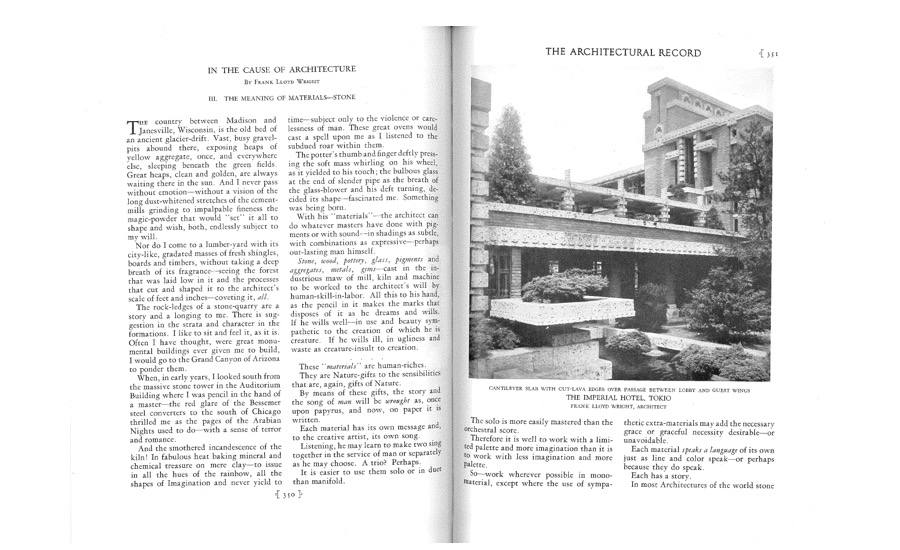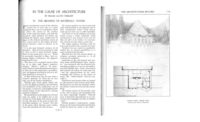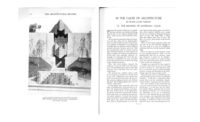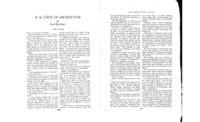From Architectural Record, April, 1928. Read a PDF of the original article here.
The country between Madison and Janesville, Wisconsin, is the old bed of an ancient glacier-drift. Vast, busy gravel-pits abound there, exposing heaps of yellow aggregate, once, and everywhere else, sleeping beneath the green fields. Great heaps, clean and golden, are always waiting there in the sun. And I never pass without emotion – without a vision of the long dust-whitened stretches of the cement-mills grinding to impalpable fineness the magic-powder that would “set” it all to shape and wish, both, endlessly subjects to my will.
Nor do I come to a lumber-yard with its city-like, gradated masses of fresh shingles, boards and timbers, without taking a deep breath of its fragrance – seeing the forest that was laid low in it and the processes that cut and shaped it to the architect’s scale of feet and inches – coveting it, all.
The rock-ledges of a stone-quarry are a story and a longing to me. There is suggestion in the strata and character in the formations. I like to sit and feel it, as it is. Often I have thought, were great monumental buildings ever given me to build, I would go to the Grand Canyon of Arizona to ponder them.
When, in early years, I looked south from the massive stone tower in the Auditorium Building where I was pencil in the hand of a master – the red glare of the Bessemer steel converters to the south of Chicago thrilled me as the pages of the Arabian Nights used to do – with a sense of terror and romance.
And the smothered incandescence of the kiln! In fabulous heat baking mineral and chemical treasure on mere clay – to issue in all the hues of the rainbow, all the shapes of Imagination and never yield to time – subject only to the violence or carelessness of man. These great ovens would cast a spell upon me as I listened to the subdued roar within them.
The potter’s thumb and finger deftly pressing the soft mass whirling on his wheel, as it yielded to his touch; the bulbous glass at the end of slender pipe as the breath of the glass-blower and his deft turning, decided its shape – fascinate me. Something was being born.
With his “materials” – the architect can do whatever masters have done with pigments or with sound – in shadings as subtle, with combinations as expressive – perhaps out-lasting man himself.
Stone, wood, pottery, glass, pigmentsand aggregates, metals, gems – cast in the industrious maw of mill, kiln and machine to be worked to the architect’s will by human-skill-in-labor. All this to his hand, as the pencil in it makes the marks that disposes of it as he dreams and wills. If he wills well – in use and beauty sympathetic to the creation of which he is creature. If he wills ill, in ugliness and waste as creature-insult to creation.
These “materials” are human riches. They are Nature-gifts to the sensibilities that are, again, gifts of Nature.
By means of these gifts, the story and the song of man will be wrought as, once upon papyrus, and now, on paper it is written.
Each material has its own message and, to the creative artist, its own song.
Listening, he may learn to make two sing together in the service of man or separately as he may choose. A trio? Perhaps.
It is easier to use them solo or in duet than manifold.
The solo is more easily mastered than the orchestral score.
Therefore it is well to work with a limited palette and more imagination than it is to work with less imagination and more palette.
So – work wherever possible in mono-material, except where the use of sympathetic extra-materials may add the necessary grace or graceful necessity desirable – or unavoidable.
Each material speaks a language of its own just as line and color speak – or perhaps because they do speak.
Each has a story.
In most Architectures of the world stone has suffered imitation of the stick. Even in oldest cultures like Chinese civilization, great constructions of stone imitate wood posts and beams in joinery – imitate literally great wood towering of poles and posts, beams, richly carved to imitate the carvings of the wooden ones that preceded them and could not endure. Undoubtedly the stick came first in architecture – came long before the stone. The ideas of forms that became associated with ideas of the beautiful in this use of wood took the more enduring material ignorant of its nature, and foolishly enslaved it to the idea of the ornamented stick.
Stone is the oldest of architectural materials on record, as to form, except as the stone itself embodies earlier wood-forms. So from Stonehenge to May masonry – the rude architecture of the Druid-Bards of whom Taliesin was one, down the ages to the intensely implicated and complicated tracery of the Goths – where stone-building may be said to have expired – stone comes first.








Post a comment to this article
Report Abusive Comment